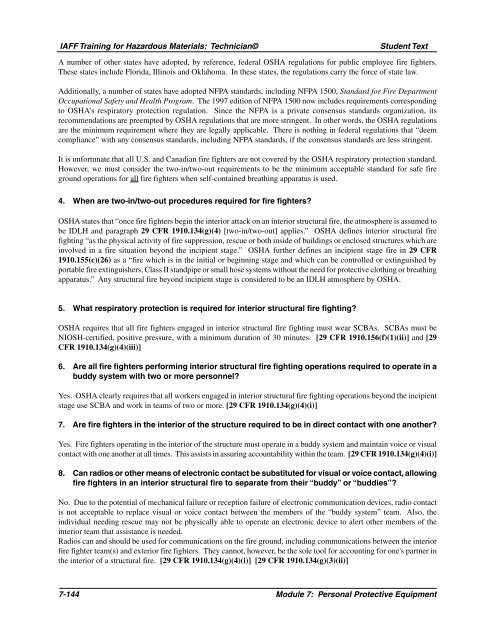Module 7 - IAFF
Module 7 - IAFF
Module 7 - IAFF
You also want an ePaper? Increase the reach of your titles
YUMPU automatically turns print PDFs into web optimized ePapers that Google loves.
<strong>IAFF</strong> Training for Hazardous Materials: Technician©<br />
Student Text<br />
A number of other states have adopted, by reference, federal OSHA regulations for public employee fire fighters.<br />
These states include Florida, Illinois and Oklahoma. In these states, the regulations carry the force of state law.<br />
Additionally, a number of states have adopted NFPA standards, including NFPA 1500, Standard for Fire Department<br />
Occupational Safety and Health Program. The 1997 edition of NFPA 1500 now includes requirements corresponding<br />
to OSHA’s respiratory protection regulation. Since the NFPA is a private consensus standards organization, its<br />
recommendations are preempted by OSHA regulations that are more stringent. In other words, the OSHA regulations<br />
are the minimum requirement where they are legally applicable. There is nothing in federal regulations that “deem<br />
compliance” with any consensus standards, including NFPA standards, if the consensus standards are less stringent.<br />
It is unfortunate that all U.S. and Canadian fire fighters are not covered by the OSHA respiratory protection standard.<br />
However, we must consider the two-in/two-out requirements to be the minimum acceptable standard for safe fire<br />
ground operations for all fire fighters when self-contained breathing apparatus is used.<br />
4. When are two-in/two-out procedures required for fire fighters?<br />
OSHA states that “once fire fighters begin the interior attack on an interior structural fire, the atmosphere is assumed to<br />
be IDLH and paragraph 29 CFR 1910.134(g)(4) [two-in/two-out] applies.” OSHA defines interior structural fire<br />
fighting “as the physical activity of fire suppression, rescue or both inside of buildings or enclosed structures which are<br />
involved in a fire situation beyond the incipient stage.” OSHA further defines an incipient stage fire in 29 CFR<br />
1910.155(c)(26) as a “fire which is in the initial or beginning stage and which can be controlled or extinguished by<br />
portable fire extinguishers, Class II standpipe or small hose systems without the need for protective clothing or breathing<br />
apparatus.” Any structural fire beyond incipient stage is considered to be an IDLH atmosphere by OSHA.<br />
5. What respiratory protection is required for interior structural fire fighting?<br />
OSHA requires that all fire fighters engaged in interior structural fire fighting must wear SCBAs. SCBAs must be<br />
NIOSH-certified, positive pressure, with a minimum duration of 30 minutes. [29 CFR 1910.156(f)(1)(ii)] and [29<br />
CFR 1910.134(g)(4)(iii)]<br />
6. Are all fire fighters performing interior structural fire fighting operations required to operate in a<br />
buddy system with two or more personnel?<br />
Yes. OSHA clearly requires that all workers engaged in interior structural fire fighting operations beyond the incipient<br />
stage use SCBA and work in teams of two or more. [29 CFR 1910.134(g)(4)(i)]<br />
7. Are fire fighters in the interior of the structure required to be in direct contact with one another?<br />
Yes. Fire fighters operating in the interior of the structure must operate in a buddy system and maintain voice or visual<br />
contact with one another at all times. This assists in assuring accountability within the team. [29 CFR 1910.134(g)(4)(i)]<br />
8. Can radios or other means of electronic contact be substituted for visual or voice contact, allowing<br />
fire fighters in an interior structural fire to separate from their “buddy” or “buddies”?<br />
No. Due to the potential of mechanical failure or reception failure of electronic communication devices, radio contact<br />
is not acceptable to replace visual or voice contact between the members of the “buddy system” team. Also, the<br />
individual needing rescue may not be physically able to operate an electronic device to alert other members of the<br />
interior team that assistance is needed.<br />
Radios can and should be used for communications on the fire ground, including communications between the interior<br />
fire fighter team(s) and exterior fire fighters. They cannot, however, be the sole tool for accounting for one's partner in<br />
the interior of a structural fire. [29 CFR 1910.134(g)(4)(i)] [29 CFR 1910.134(g)(3)(ii)]<br />
7-144 <strong>Module</strong> 7: Personal Protective Equipment
















